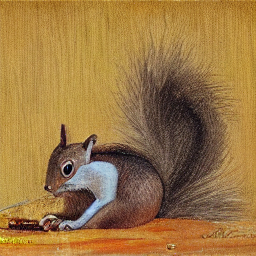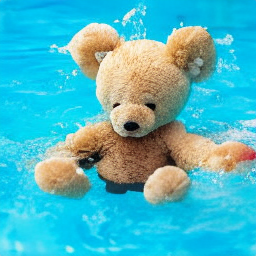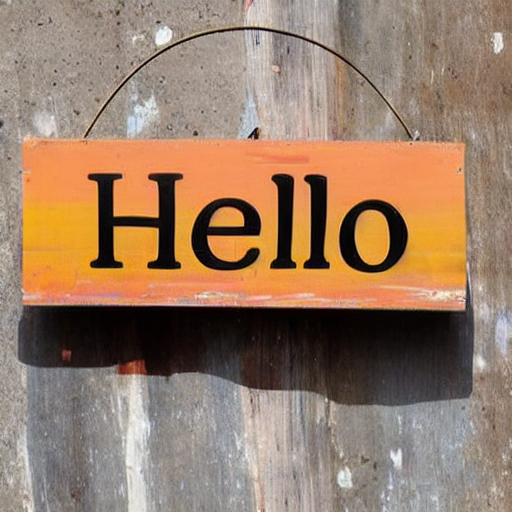latent-diffusion-text2img
Maintainer: cjwbw

4

| Property | Value |
|---|---|
| Run this model | Run on Replicate |
| API spec | View on Replicate |
| Github link | View on Github |
| Paper link | View on Arxiv |
Create account to get full access
Model overview
The latent-diffusion-text2img model is a text-to-image AI model developed by cjwbw, a creator on Replicate. It uses latent diffusion, a technique that allows for high-resolution image synthesis from text prompts. This model is similar to other text-to-image models like stable-diffusion, stable-diffusion-v2, and stable-diffusion-2-1-unclip, which are also capable of generating photo-realistic images from text.
Model inputs and outputs
The latent-diffusion-text2img model takes a text prompt as input and generates an image as output. The text prompt can describe a wide range of subjects, from realistic scenes to abstract concepts, and the model will attempt to generate a corresponding image.
Inputs
- Prompt: A text description of the desired image.
- Seed: An optional seed value to enable reproducible sampling.
- Ddim steps: The number of diffusion steps to use during sampling.
- Ddim eta: The eta parameter for the DDIM sampler, which controls the amount of noise injected during sampling.
- Scale: The unconditional guidance scale, which controls the balance between the text prompt and the model's own prior.
- Plms: Whether to use the PLMS sampler instead of the default DDIM sampler.
- N samples: The number of samples to generate for each prompt.
Outputs
- Image: A high-resolution image generated from the input text prompt.
Capabilities
The latent-diffusion-text2img model is capable of generating a wide variety of photo-realistic images from text prompts. It can create scenes with detailed objects, characters, and environments, as well as more abstract and surreal imagery. The model's ability to capture the essence of a text prompt and translate it into a visually compelling image makes it a powerful tool for creative expression and visual storytelling.
What can I use it for?
You can use the latent-diffusion-text2img model to create custom images for various applications, such as:
- Illustrations and artwork for books, magazines, or websites
- Concept art for games, films, or other media
- Product visualization and design
- Social media content and marketing assets
- Personal creative projects and artistic exploration
The model's versatility allows you to experiment with different text prompts and see how they are interpreted visually, opening up new possibilities for artistic expression and collaboration between text and image.
Things to try
One interesting aspect of the latent-diffusion-text2img model is its ability to generate images that go beyond the typical 256x256 resolution. By adjusting the H and W arguments, you can instruct the model to generate larger images, up to 384x1024 or more. This can result in intriguing and unexpected visual outcomes, as the model tries to scale up the generated imagery while maintaining its coherence and detail.
Another thing to try is using the model's "retrieval-augmented" mode, which allows you to condition the generation on both the text prompt and a set of related images retrieved from a database. This can help the model better understand the context and visual references associated with the prompt, potentially leading to more interesting and faithful image generation.
This summary was produced with help from an AI and may contain inaccuracies - check out the links to read the original source documents!
Related Models

vq-diffusion

20
vq-diffusion is a text-to-image synthesis model developed by cjwbw. It is similar to other diffusion models like stable-diffusion, stable-diffusion-v2, latent-diffusion-text2img, clip-guided-diffusion, and van-gogh-diffusion, all of which are capable of generating photorealistic images from text prompts. The key innovation in vq-diffusion is the use of vector quantization to improve the quality and coherence of the generated images. Model inputs and outputs vq-diffusion takes in a text prompt and various parameters to control the generation process. The outputs are one or more high-quality images that match the input prompt. Inputs prompt**: The text prompt describing the desired image. image_class**: The ImageNet class label to use for generation (if generation_type is set to ImageNet class label). guidance_scale**: A value that controls the strength of the text guidance during sampling. generation_type**: Specifies whether to generate from in-the-wild text, MSCOCO datasets, or ImageNet class labels. truncation_rate**: A value between 0 and 1 that controls the amount of truncation applied during sampling. Outputs An array of generated images that match the input prompt. Capabilities vq-diffusion can generate a wide variety of photorealistic images from text prompts, spanning scenes, objects, and abstract concepts. It uses vector quantization to improve the coherence and fidelity of the generated images compared to other diffusion models. What can I use it for? vq-diffusion can be used for a variety of creative and commercial applications, such as visual art, product design, marketing, and entertainment. For example, you could use it to generate concept art for a video game, create unique product visuals for an e-commerce store, or produce promotional images for a new service or event. Things to try One interesting aspect of vq-diffusion is its ability to generate images that mix different visual styles and concepts. For example, you could try prompting it to create a "photorealistic painting of a robot in the style of Van Gogh" and see the results. Experimenting with different prompts and parameter settings can lead to some fascinating and unexpected outputs.
Updated Invalid Date

textdiffuser

1
textdiffuser is a diffusion model created by Replicate contributor cjwbw. It is similar to other powerful text-to-image models like stable-diffusion, latent-diffusion-text2img, and stable-diffusion-v2. These models use diffusion techniques to transform text prompts into detailed, photorealistic images. Model inputs and outputs The textdiffuser model takes a text prompt as input and generates one or more corresponding images. The key input parameters are: Inputs Prompt**: The text prompt describing the desired image Seed**: A random seed value to control the image generation Guidance Scale**: A parameter that controls the influence of the text prompt on the generated image Num Inference Steps**: The number of denoising steps to perform during image generation Outputs Output Images**: One or more generated images corresponding to the input text prompt Capabilities textdiffuser can generate a wide variety of photorealistic images from text prompts, ranging from scenes and objects to abstract art and stylized depictions. The quality and fidelity of the generated images are highly impressive, often rivaling or exceeding human-created artwork. What can I use it for? textdiffuser and similar diffusion models have a wealth of potential applications, from creative tasks like art and illustration to product visualization, scene generation for games and films, and much more. Businesses could use these models to rapidly prototype product designs, create promotional materials, or generate custom images for marketing campaigns. Creatives could leverage them to ideate and explore new artistic concepts, or to bring their visions to life in novel ways. Things to try One interesting aspect of textdiffuser and related models is their ability to capture and reproduce specific artistic styles, as demonstrated by the van-gogh-diffusion model. Experimenting with different styles, genres, and creative prompts can yield fascinating and unexpected results. Additionally, the clip-guided-diffusion model offers a unique approach to image generation that could be worth exploring further.
Updated Invalid Date

stable-diffusion-v2

277
The stable-diffusion-v2 model is a test version of the popular Stable Diffusion model, developed by the AI research group Replicate and maintained by cjwbw. The model is built on the Diffusers library and is capable of generating high-quality, photorealistic images from text prompts. It shares similarities with other Stable Diffusion models like stable-diffusion, stable-diffusion-2-1-unclip, and stable-diffusion-v2-inpainting, but is a distinct test version with its own unique properties. Model inputs and outputs The stable-diffusion-v2 model takes in a variety of inputs to generate output images. These include: Inputs Prompt**: The text prompt that describes the desired image. This can be a detailed description or a simple phrase. Seed**: A random seed value that can be used to ensure reproducible results. Width and Height**: The desired dimensions of the output image. Init Image**: An initial image that can be used as a starting point for the generation process. Guidance Scale**: A value that controls the strength of the text-to-image guidance during the generation process. Negative Prompt**: A text prompt that describes what the model should not include in the generated image. Prompt Strength**: A value that controls the strength of the initial image's influence on the final output. Number of Inference Steps**: The number of denoising steps to perform during the generation process. Outputs Generated Images**: The model outputs one or more images that match the provided prompt and other input parameters. Capabilities The stable-diffusion-v2 model is capable of generating a wide variety of photorealistic images from text prompts. It can produce images of people, animals, landscapes, and even abstract concepts. The model's capabilities are constantly evolving, and it can be fine-tuned or combined with other models to achieve specific artistic or creative goals. What can I use it for? The stable-diffusion-v2 model can be used for a variety of applications, such as: Content Creation**: Generate images for articles, blog posts, social media, or other digital content. Concept Visualization**: Quickly visualize ideas or concepts by generating relevant images from text descriptions. Artistic Exploration**: Use the model as a creative tool to explore new artistic styles and genres. Product Design**: Generate product mockups or prototypes based on textual descriptions. Things to try With the stable-diffusion-v2 model, you can experiment with a wide range of prompts and input parameters to see how they affect the generated images. Try using different types of prompts, such as detailed descriptions, abstract concepts, or even poetry, to see the model's versatility. You can also play with the various input settings, such as the guidance scale and number of inference steps, to find the right balance for your desired output.
Updated Invalid Date

clip-guided-diffusion

4
clip-guided-diffusion is a Cog implementation of the CLIP Guided Diffusion model, originally developed by Katherine Crowson. This model leverages the CLIP (Contrastive Language-Image Pre-training) technique to guide the image generation process, allowing for more semantically meaningful and visually coherent outputs compared to traditional diffusion models. Unlike the Stable Diffusion model, which is trained on a large and diverse dataset, clip-guided-diffusion is focused on generating images from text prompts in a more targeted and controlled manner. Model inputs and outputs The clip-guided-diffusion model takes a text prompt as input and generates a set of images as output. The text prompt can be anything from a simple description to a more complex, imaginative scenario. The model then uses the CLIP technique to guide the diffusion process, resulting in images that closely match the semantic content of the input prompt. Inputs Prompt**: The text prompt that describes the desired image. Timesteps**: The number of diffusion steps to use during the image generation process. Display Frequency**: The frequency at which the intermediate image outputs should be displayed. Outputs Array of Image URLs**: The generated images, each represented as a URL. Capabilities The clip-guided-diffusion model is capable of generating a wide range of images based on text prompts, from realistic scenes to more abstract and imaginative compositions. Unlike the more general-purpose Stable Diffusion model, clip-guided-diffusion is designed to produce images that are more closely aligned with the semantic content of the input prompt, resulting in a more targeted and coherent output. What can I use it for? The clip-guided-diffusion model can be used for a variety of applications, including: Content Generation**: Create unique, custom images to use in marketing materials, social media posts, or other visual content. Prototyping and Visualization**: Quickly generate visual concepts and ideas based on textual descriptions, which can be useful in fields like design, product development, and architecture. Creative Exploration**: Experiment with different text prompts to generate unexpected and imaginative images, opening up new creative possibilities. Things to try One interesting aspect of the clip-guided-diffusion model is its ability to generate images that capture the nuanced semantics of the input prompt. Try experimenting with prompts that contain specific details or evocative language, and observe how the model translates these textual descriptions into visually compelling outputs. Additionally, you can explore the model's capabilities by comparing its results to those of other diffusion-based models, such as Stable Diffusion or DiffusionCLIP, to understand the unique strengths and characteristics of the clip-guided-diffusion approach.
Updated Invalid Date